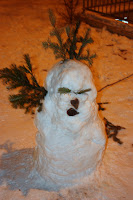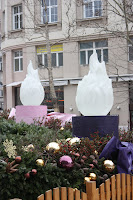 With each day, living in Hungary brings both more familiarity and more new discoveries. After another great language class this morning with Erika, interacting with Hungarians in their native tongue becomes more comfortable and not unsatisfying, even if dialogues are limited to a few words in Hungarian before we are resigned to asking "nem beszelek magyarul; beszel angolul?" ("I don't speak Hungarian; do you speak English?").
With each day, living in Hungary brings both more familiarity and more new discoveries. After another great language class this morning with Erika, interacting with Hungarians in their native tongue becomes more comfortable and not unsatisfying, even if dialogues are limited to a few words in Hungarian before we are resigned to asking "nem beszelek magyarul; beszel angolul?" ("I don't speak Hungarian; do you speak English?"). This afternoon, we traveled to the Renyi Institute, housed in a beautiful building in central Pest (the side of the city east of the Danube). There, Miklos Dezso, a professor of math and member of the Renyi Institute, lectured on some combinatorics researched by Paul Erdos, one of Hungary's most famous mathematicians and the most prolific mathematician of all time! After the professor's interactive talk, we watched a documentary film about the peripatetic Erdos. Our visit to Renyi gave us some first-hand experience and appreciation for why Hungary is one of the world's centers of mathematics.
After our departure from Renyi, we split up, using the metro, trams, and our own two legs to go our separate ways. The public transporation in Budapest is incredible -- the multiple networks of trams, buses, and metros makes getting around the city very easy, although not without its hazards: the numbering and schedules of the various modes of transit can be complicated for strangers to the city, making it potentially challenging to explore new destinations -- especially when some of the bus workers are on strike, and the buses deviate from their already enigmatic routes!
As St. Olaf students, we are more than used to the Minnesotan winter weather - aka SNOW! The past few days in Budapest have proven few differences as the forecast allowed for an accumulation of this frozen precipitation.


For many of us, Budapest is our first urban experience in the winter, especially when comparing the city to the quaint town of Northfield. Snow pummeling from high rooftops was one of our first issues. Don't worry, all students have been safe from the falling snow piles, except for minor close encount ers. We have also discovered the way in which slush collects on the streets. This is only problematic when standing too close to the curbs and frantic drivers hit the slush just right. Wet!
ers. We have also discovered the way in which slush collects on the streets. This is only problematic when standing too close to the curbs and frantic drivers hit the slush just right. Wet!
 ers. We have also discovered the way in which slush collects on the streets. This is only problematic when standing too close to the curbs and frantic drivers hit the slush just right. Wet!
ers. We have also discovered the way in which slush collects on the streets. This is only problematic when standing too close to the curbs and frantic drivers hit the slush just right. Wet! We have also learned that during the winter months, the city of Budapest covers the majority of their statues in protective coverings. This is done to preserve the statues from the harsh  effects of the cold, snow, and ice. Although this made it difficult to see some of the statues, others had a clear covering so we were still able to see the statues. Phew!
effects of the cold, snow, and ice. Although this made it difficult to see some of the statues, others had a clear covering so we were still able to see the statues. Phew!
 effects of the cold, snow, and ice. Although this made it difficult to see some of the statues, others had a clear covering so we were still able to see the statues. Phew!
effects of the cold, snow, and ice. Although this made it difficult to see some of the statues, others had a clear covering so we were still able to see the statues. Phew! As the ground continued to get covered by snow, we began to notice snowmen popping up around the city. However, these  snowmen were not characteristic of the snowmen we find in America. These features added a lot of character that is missing in their American counter-parts. In addition to the traditional buttons, eyes, mouths and stick arms, many of these snowmen had features such as crowns and badges. We found it especially interesting that some of these snowmen had arms and noses made out of snow and actual eye sockets carved to put their button eyes in. Overall, we think
snowmen were not characteristic of the snowmen we find in America. These features added a lot of character that is missing in their American counter-parts. In addition to the traditional buttons, eyes, mouths and stick arms, many of these snowmen had features such as crowns and badges. We found it especially interesting that some of these snowmen had arms and noses made out of snow and actual eye sockets carved to put their button eyes in. Overall, we think  that Hungarian snowmen are a lot cooler and more creative than American snowmen.
that Hungarian snowmen are a lot cooler and more creative than American snowmen.
 snowmen were not characteristic of the snowmen we find in America. These features added a lot of character that is missing in their American counter-parts. In addition to the traditional buttons, eyes, mouths and stick arms, many of these snowmen had features such as crowns and badges. We found it especially interesting that some of these snowmen had arms and noses made out of snow and actual eye sockets carved to put their button eyes in. Overall, we think
snowmen were not characteristic of the snowmen we find in America. These features added a lot of character that is missing in their American counter-parts. In addition to the traditional buttons, eyes, mouths and stick arms, many of these snowmen had features such as crowns and badges. We found it especially interesting that some of these snowmen had arms and noses made out of snow and actual eye sockets carved to put their button eyes in. Overall, we think  that Hungarian snowmen are a lot cooler and more creative than American snowmen.
that Hungarian snowmen are a lot cooler and more creative than American snowmen.Although most of us spent our holiday season in the United States, we have been able to enjoy a few days of Christmas decorations here in Budapest. Many of the main city squares and streets, including those of our daily trek to and from school, are lined with Christmas lights and decorations.
 Additionally, many shopping centers have Christmas trees of various sizes. One of the most spectacular displays was that which was staged outside of the Basilica, consisting of some pine trees surrounding four plastic flames that we saw during our day-tour. Unfortunately, when we returned to see these flames at night, this decoration had been removed. Furthermore, we have
Additionally, many shopping centers have Christmas trees of various sizes. One of the most spectacular displays was that which was staged outside of the Basilica, consisting of some pine trees surrounding four plastic flames that we saw during our day-tour. Unfortunately, when we returned to see these flames at night, this decoration had been removed. Furthermore, we have seen a surge of Christmas trees being thrown out onto curbs. It seems that the time for Christmas decorations in Budapest is coming to an end.
seen a surge of Christmas trees being thrown out onto curbs. It seems that the time for Christmas decorations in Budapest is coming to an end.
 Additionally, many shopping centers have Christmas trees of various sizes. One of the most spectacular displays was that which was staged outside of the Basilica, consisting of some pine trees surrounding four plastic flames that we saw during our day-tour. Unfortunately, when we returned to see these flames at night, this decoration had been removed. Furthermore, we have
Additionally, many shopping centers have Christmas trees of various sizes. One of the most spectacular displays was that which was staged outside of the Basilica, consisting of some pine trees surrounding four plastic flames that we saw during our day-tour. Unfortunately, when we returned to see these flames at night, this decoration had been removed. Furthermore, we have
Something that immediately catches the eye unaccustomed to Budapest is the architecture -- not only its distinctively European style, but the stark contrast between the condition of the structures. A number of the facades are quite dark, sometimes nearly black, from the city's historically polluting coal burning, while other buildings -- often in close proximity to the dirty ones -- are beautifully pristine, cleaned and restored exemplars of the finest European Secessionist and Art Nouveau architecture.
To close, we present a tip/tidbit of cultural education for any aspiring travelers to the lovely city of Budapest: if you find yourself dining in a restaurant that doesn't serve czaptiz (tap water), you have to choose between carbonated and non-carbonated bottled water. However, do not be surprised when the Hungarians do not refer to carbonated and non-carbonated water as such, but rather as "with or without gas."


Love the snowmen!
ReplyDeleteGreat post. I think the snowmen (and women) put it over the top.
ReplyDelete